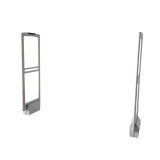Have you ever wondered how RFID scanners are transforming business operations? Radio-frequency identification (RFID) technology is revolutionizing the way businesses manage and track their assets, whether you are overseeing inventory in a warehouse, ensuring equipment security in a hospital, or streamlining processes in retail. Discover the benefits of implementing RFID systems in your organization today.
This article will explore how RFID scanners work, the different types available, their applications across industries, the challenges they face, and future trends. By understanding these aspects, you can make informed decisions about integrating RFID technology into your operations.
Table of contents
Understanding RFID system components
RFID (Radio Frequency Identification) technology uses electromagnetic fields to automatically identify and track tags attached to objects. These tags contain electronically stored information that can be read from a distance using RFID readers. This technology enhances efficiency in various sectors, including retail, logistics, and healthcare, by enabling real-time tracking, inventory management, and data collection without direct line-of-sight, making operations more streamlined and accurate.
An RFID system is composed of three main components:
- RFID tags: These are small devices that contain a microchip and an antenna. The microchip stores data, while the antenna transmits this data to the RFID reader.
- RFID readers: These devices emit radio waves and receive signals from RFID tags. They can be handheld or fixed and often include data processing software.
- Antenna: This element is crucial for both tags and readers. In tags, it helps transmit data; in readers, it enhances signal reception.
Types of RFID tags
There are three primary types of RFID tags:
- Active tags
Power source: Internal battery.
Range: Up to 100 meters.
Applications: Asset tracking in large areas like warehouses.
- Passive tags
Power source: Energy from the reader’s radio waves.
Range: Up to 25 meters.
Applications: Item-level tagging in retail.
- Semi-passive tags
Power source: Internal battery for powering the chip but relies on the reader for communication.
Range: Similar to passive tags.
Applications: Monitoring environmental conditions such as temperature.
Role of RFID readers and antennas
RFID readers and antennas play a pivotal role in the scanning process:
- Readers: Emit radio waves that activate RFID tags. Once activated, these tags send their stored data back to the reader.
- Antennas: Enhance the signal strength, ensuring accurate and efficient data transmission.
Together, these components facilitate seamless data capture, enabling businesses to track inventory, monitor conditions, and streamline operations across various industries.
How RFID scanners work
RFID scanners work by using radio waves, electromagnetic fields, and data transmission methods. Here’s a breakdown of the process:
1. Emission of radio waves
An RFID reader continuously sends out radio waves. When an RFID tag enters the reader’s electromagnetic field, it captures this energy.
2. Energy absorption by tags
Passive tags use energy from the reader’s radio waves to power their circuits. Active and semi-passive tags have their own power source but still rely on the reader for sending data.
3. Data transmission
Once powered, the tag sends data back to the RFID reader. This information usually includes a unique identifier and possibly additional data about the tagged item.
4. Decoding process
The RFID reader picks up these signals and decodes them into a digital format that can be processed by computer systems. The decoded data is then used for various applications such as inventory management or asset tracking.
RFID scanners are incredibly useful in industries like retail, logistics, and healthcare because they can read multiple tags at once and from different distances. Their effectiveness relies on smooth communication between tags and readers through complex electromagnetic interactions.
Types of RFID systems
RFID systems operate across various frequency ranges, each with distinct characteristics and applications:
Low frequency (LF)
- Frequency range: 30 kHz to 300 kHz
- Characteristics: Short read range (up to 10 cm), low data transfer rate
- Applications: Animal tracking, access control, and asset tracking in harsh environments
High frequency (HF)
- Frequency range: 3 MHz to 30 MHz (commonly at 13.56 MHz)
- Characteristics: Moderate read range (up to 1 meter), higher data transfer rate than LF
- Applications: Contactless payments, smart cards, and library book management
Ultra-high frequency (UHF)
- Frequency range: 300 MHz to 3 GHz (commonly between 860 MHz and 960 MHz)
- Characteristics: Long read range (up to 12 meters), fast data transfer rate, sensitivity to metal and liquids
- Applications: Supply chain management, inventory control, and cargo tracking
Microwave
- Frequency range: Above 3 GHz (commonly at 2.45 GHz or 5.8 GHz)
- Characteristics: Very long read range, high data transfer rate, potential interference from environmental factors
- Applications: Toll collection systems, high-speed train tracking, and real-time location systems
Choosing the appropriate frequency depends on several factors:
- Read range requirements: Longer distances favor UHF or microwave frequencies.
- Environment conditions: LF is ideal for metal-heavy or liquid-rich environments.
- Data transfer needs: HF and UHF provide faster data rates suitable for applications requiring swift transactions.
Selecting the right frequency ensures optimal performance tailored to specific industry needs.
Applications of RFID scanners in industries
RFID technology has transformed numerous industries, enhancing efficiency and accuracy. Here are some notable applications:
Retail
- Inventory management: RFID tags enable real-time tracking of products, reducing stock discrepancies and improving restocking processes.
- Loss prevention: By integrating RFID scanners at store exits, retailers can deter theft and monitor product movement.
Logistics and supply chain
- Asset tracking: RFID systems provide visibility into the location and status of assets, ensuring timely deliveries and reducing loss.
- Warehouse management: Automating inventory checks with RFID reduces manual labor and errors, enhancing operational efficiency.
Healthcare
- Patient tracking: Hospitals use RFID to monitor patient movements and ensure timely medical interventions.
- Equipment management: Critical medical equipment tagged with RFID helps in quick location identification, crucial during emergencies.
Manufacturing
- Production line monitoring: RFID tags on components allow manufacturers to track production stages, ensuring quality control and timely process completion.
- Tool tracking: Ensuring that tools are always available when needed increases productivity and reduces downtime.
Agriculture
- Livestock management: Farmers use RFID to track animal health records, breeding histories, and location within large farms.
- Crop monitoring: Tagging equipment used in crop fields helps in the efficient management of resources such as fertilizers and pesticides.
Aviation
- Baggage handling: Airports employ RFID technology to streamline baggage tracking, reducing instances of lost luggage.
- Maintenance checks: Aircraft parts tagged with RFID facilitate maintenance schedules and enhance safety compliance.
These examples illustrate the diverse utility of RFID across sectors, driving productivity and operational excellence.






Challenges associated with implementing RFID systems effectively
Security concerns
RFID technology, while highly beneficial, carries certain security risks. Unauthorized reading is one notable concern; malicious actors could potentially read sensitive information stored on RFID tags without consent. This unauthorized access can lead to data breaches during transmission, exposing confidential information.
To mitigate these security concerns, organizations can consider the following measures:
- Encryption: Implementing advanced encryption methods can help protect the data transmitted between tags and readers.
- Authentication Protocols: Ensuring that only authorized readers can access tag information by using robust authentication protocols is crucial.
Reader/tag collision issues
During the scanning process, reader or tag collisions are common challenges that can disrupt efficient RFID system operation.
Reader collision
Reader collision occurs when signals from two or more readers overlap, causing interference and data loss. To manage multiple reader signals effectively, employing anti-collision algorithms is essential.
Tag collision
Tag collision happens when multiple tags respond simultaneously to a single reader query, leading to signal confusion. Utilizing protocols like Time Division Multiple Access (TDMA) can help control tag response timing and reduce collisions.
Addressing these challenges ensures the effective and secure implementation of RFID systems across various industries.
Future trends of RFID technology
This section discusses about the future trends of shaping the evolution of RFID technology to various sectors.
1. Advancements in miniaturization and enhanced encryption methods
Recent advancements in technology, such as miniaturization and enhanced encryption methods, are paving the way for more secure RFID systems. Smaller RFID tags are now easier to integrate into a variety of products without compromising on performance. Enhanced encryption methods significantly reduce vulnerabilities to hacking attempts, targeting potential weak points within an organization’s infrastructure.
2. Integration with IoT devices
The integration with IoT devices is revolutionizing the utility of RFID systems. Beyond just identifying physical assets, these integrations enable real-time monitoring of environmental conditions. For example, temperature fluctuations affecting perishables stored in cold storage facilities can now be tracked accurately, ensuring better quality control and reduced spoilage.
3. Cost reductions and increased adoption rates
Technological advancements are also driving down deployment costs, making RFID systems more accessible across various sectors. The complexity levels previously encountered during scaling operations across multiple locations are being mitigated, allowing for wider adoption without sacrificing performance standards.
4. Future development path
Manufacturers are focusing on seamlessly integrating these devices with existing systems like ERP platforms. This integration facilitates end-to-end visibility throughout supply chains, which is crucial for both businesses and consumers. The real-time data collected enhances operational efficiency and provides actionable insights that drive decision-making processes.
These emerging trends indicate a robust future for RFID technology, setting the stage for innovative applications across industries.
Asecuri’s comprehensive suite
Asecuri offers a cutting-edge suite designed to address the unique challenges faced by modern businesses. This suite includes:
- Advanced RFID scanners: State-of-the-art devices ensuring accurate and efficient data capture across various environments.
- Integrated software solutions: Seamlessly connect your RFID system with existing ERP platforms, enhancing end-to-end visibility throughout supply chains.
- Enhanced security features: Utilizing the latest encryption methods to safeguard data against unauthorized access and breaches.
- Customizable options: Tailored solutions to meet specific industry needs, whether in retail, logistics, or healthcare.
The RFID solutions by Asecuri also support real-time monitoring through IoT integration, allowing businesses to track not only assets but also environmental conditions such as temperature and humidity. This expanded utility is particularly beneficial for industries like healthcare and pharmaceuticals where maintaining precise conditions is crucial.
Hence, adopting Asecuri’s comprehensive RFID suite ensures you’re equipped with the tools needed to stay competitive in today’s fast-paced market. By leveraging advanced technology and robust security features, you can streamline operations and focus on growth.
Conclusion
Embracing innovation through automation-powered solutions is essential in today’s fast-paced business environment. Asecuri’s comprehensive RFID Scanners are designed to address the unique challenges faced by modern businesses, especially those operating on a global scale where speed is crucial. With time-sensitive transactions occurring constantly, Asecuri ensures seamless operations regardless of physical proximity between parties.
Take action now!
Don’t let your business fall behind in the fast-paced world of inventory management and asset tracking. Harness the power of Asecuri’s customized security solutions tailored to meet your unique needs.
Experience seamless integration, advanced RFID technology, and enhanced security features that will revolutionize your operations.
Visit Asecuri today to learn more about our comprehensive RFID solutions and take the first step towards smarter, more secure business operations!


































